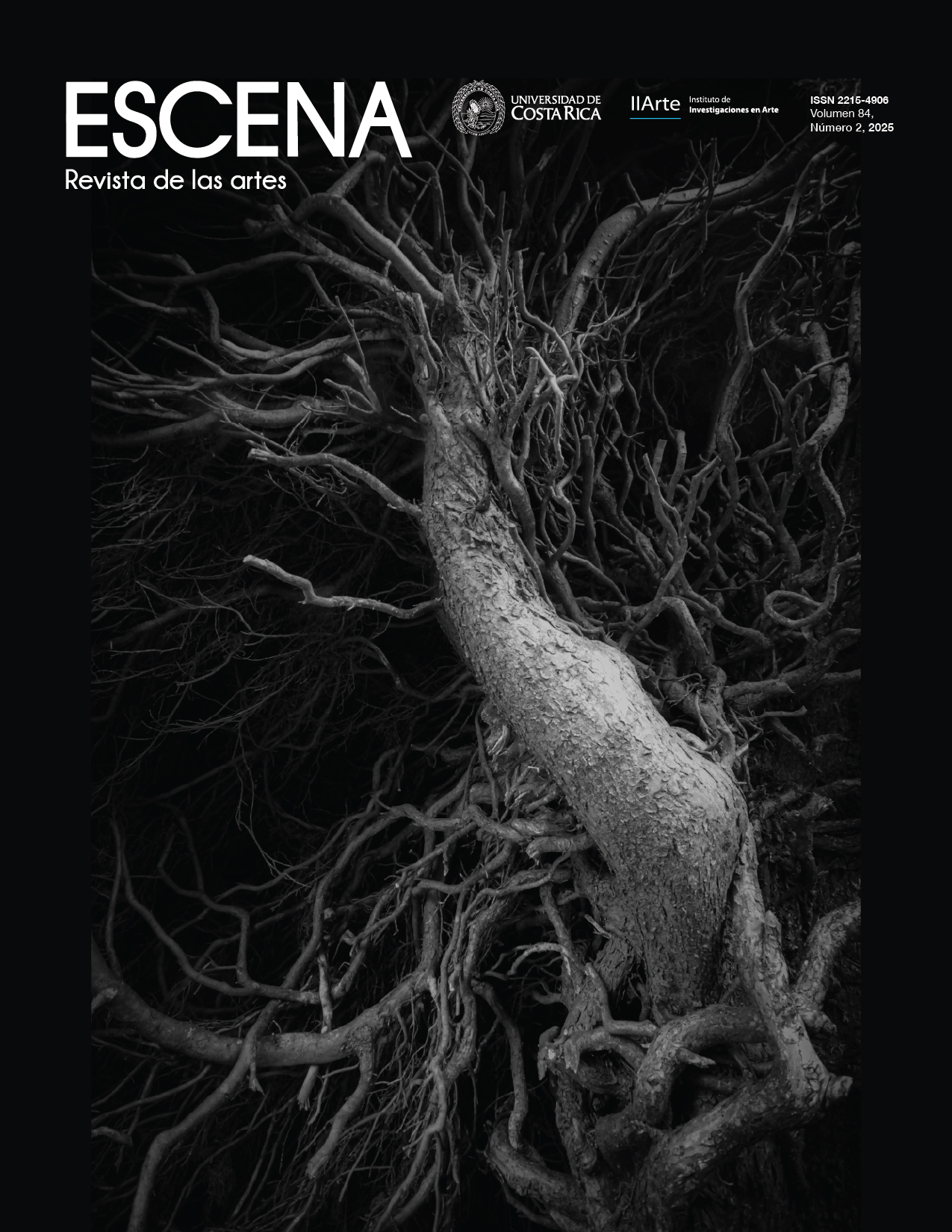Abstract
Introduction: Film adaptations created from plays have become a favorable area to examine the intermedial and transdisciplinary relationships between both artistic practices. Objective: This paper aims to analyze the intermedial relationships that can be found between La casa vieja, a play by Cuban Abelardo Estorino, and Casa vieja, its film version, by the Cuban Lester Hamlet, in order to investigate the productivity of the dialogue that occurs between theater and cinema. Methods: We have developed a comparative analysis among some relevant elements of both works, which allow us to establish connections and find differences between the two examined artistic mediums. Results: In a general sense, it is possible to establish that, in the film, a transposition of the play is carried out, through which Estorino’s piece is rewritten, giving it new meanings. Conclusions: In Casa vieja, it is possible to find the presence of different procedures and intermedial figures, which allow us to appreciate the film’s reevaluation of the play, as well as the productivity of updating and transposing it to a new context and different medium. The marks of theatricality within the movie also make it possible to reflect on the conflicts and social problems raised through its plot.
References
Bazin, A. (1990). ¿Qué es el cine? Ediciones Rialp.
Benson, D. S. (2016). Antiracism in Cuba: The Unfinished Revolution. University of North Carolina Press.
Bissonnette, S. (2008). La théâtralité cinématographique engagée. Nouvelles «vues» sur le cinéma québécois, (8), 1-29. https://nouvellesvues.org/wp-content/uploads/2021/09/BissonnetteNVCQ8.pdf
Bloch, V. (2009). Reflexiones sobre la disidencia cubana. Análisis político, (67), 83-104. http://www.scielo.org.co/pdf/anpol/v22n67/v22n67a05.pdf
Bolter, J. D., & Grusin, R. (2000). Remediation. Understanding New Media. Massachusetts Institute of Technology Press.
Bongers, W. (2015). Figuras intermediales en Teorema. AISTHESIS, (58), 353-361. http://dx.doi.org/10.4067/S0718-71812015000200021
Bongers, W. (2018). Tránsitos intermediales: las imágenes del cine y la televisión en Mantra. Cuadernos de Literatura, 22(44), 101-122. https://doi.org/10.11144/Javeriana.cl22-44.tiic
Casetti, F., & Di Chio, F. (1991). Cómo analizar un film. Paidós.
Chase, M. (2015). Revolution Within the Revolution. Women and Gender Politics in Cuba, 1952–1962. The University of North Carolina Press.
Chirino, L. J. (2021, 21 de octubre). Polémica por veto en televisión de película “Casa Vieja” en Día de la Cultura Cubana.
del Río, J. (2011, 10 de enero). La casa vieja remozada en el cine cubano. Rebelión. https://rebelion.org/la-casa-vieja-remozada-en-el-cine-cubano/
Estorino, A. (2010). La casa vieja. En O. Valiño (Comp.), Dramaturgia de la Revolución (1959-2008) (vol. 1, pp. 151-199). Ediciones Alarcos.
Fernández Pérez, G. (2011). Las masculinidades en el cine: un acercamiento a Casa vieja. Contribuciones a las Ciencias Sociales. https://www.eumed.net/rev/cccss/13/gfp.htm
Gallardo Saborido, E. J. (2013). Escapando del laberinto del género: revolución y liberación femenina en la dramaturgia de Abelardo Estorino. Hispanic Research Journal, 14(4), 313-323. https://doi.org/10.1179/1468273713Z.00000000051
Garramuño, F. (2014). Arte inespecífico y mundos en común. En Estética, medios masivos y subjetividades. Ponencias del V Simposio Internacional de Estética (2014) (pp. 15-29). Estética UC Online.
Guerra, S. (2021). La Revolución Cubana. Un nuevo panorama de su historia (1953-2020). Navegando Publicações.
Hamlet, L. (Director). (2010). Casa vieja [película]. Instituto Cubano del Arte e Industria Cinematográficos.
Higgins, D. (1966). Intermedia. The Something Else Newsletter, (1), 1-6.
Mazzina, C., & Isern, P. (Comp.). (2023). La disidencia cubana: Experiencias y aprendizajes para la democratización. Dunken.
Mendoza, I. (2008). La obra de Abelardo Estorino. En S. Chaple (Dir.), Historia de la literatura cubana. Tomo III (pp. 370-379). Editorial Letras Cubanas.
Mesa-Lago, C. (2005). Problemas sociales y económicos en Cuba durante la crisis y la recuperación. Revista de la CEPAL, (86), 183-205. https://repositorio.cepal.org/server/api/core/bitstreams/8845de39-7a99-4c9f-8858-1238521066a4/content
Mesa-Lago, C. (2009). Balance económico-social de 50 años de Revolución en Cuba. América Latina Hoy, (52), 41-61. https://doi.org/10.14201/alh.5675
Mitchell, W. J. T. (1986). Iconology: Image, Text, Ideology. The University of Chicago Press.
Montaner, C. A. (1976). Informe secreto sobre la Revolución Cubana. Ediciones Sedmay.
Montaner, C. A. (1999). Viaje al corazón de Cuba. Plaza y Janés.
Padrón, F. (2011, 31 de enero). «Casa vieja», un conflicto más viejo que la casa. Noticine. http://noticine.com/iberoamerica/36-iberoamerica/14542-critica-qcasa-viejaq-un-conflicto-mas-viejo-que-la-casa.html
Periódico Cubano. (2021, 22 de octubre). Televisión Cubana censura el filme “Casa vieja” por razones políticas. https://www.periodicocubano.com/television-cubana-censura-el-filme-casa-vieja-por-razones-politicas/
Qiang, C. (2016). Las adaptaciones de las obras teatrales de Abelardo Estorino en el cine cubano: “El robo del cochino” y “La casa vieja” [Tesis de maestría, Universidad de La Habana, Cuba]. Scriptorium. https://fototeca.uh.cu/s/scriptorium/item/2129412#lg=1&slide=0
Rajewsky, I. O. (2005). Intermediality, Intertextuality, and Remediation: A Literary Perspective on Intermediality. Intermédialités / Intermediality, (6), 43-64. https://doi.org/10.7202/1005505ar
Rajewsky, I. O. (2010). Border Talks: The Problematic Status of Media Borders in the Current Debate about Intermediality. En L. Elleström (Ed.), Media Borders, Multimodality and Intermediality (pp. 51-68). Palgrave Macmillan.
Rancière, J. (2012). Las distancias del cine. Manantial.
Rosenstone, R. A. (2013). Cine y visualidad. Historización de la imagen contemporánea. Ediciones Universidad Finis Terrae.
Salas Murillo, B. (2017). Apuntes a la trans-escritura: el caso del par teatro-cine. ESCENA. Revista de las artes, 76(2), 10-27. https://doi.org/10.15517/es.v76i2.28063
Speranza, G. (2006). Fuera de campo. Literatura y arte argentinos después de Duchamp. Editorial Anagrama.
Thomas, H. (2004). Cuba. La lucha por la libertad. Debate.
Wolf, S. (2001). Cine/Literatura. Ritos de pasaje. Editorial Paidós.
##plugins.facebook.comentarios##

This work is licensed under a Creative Commons Attribution-NonCommercial-NoDerivatives 4.0 International License.
Copyright (c) 2025 Aluned Moreno del Cristo



